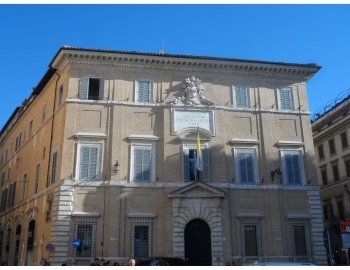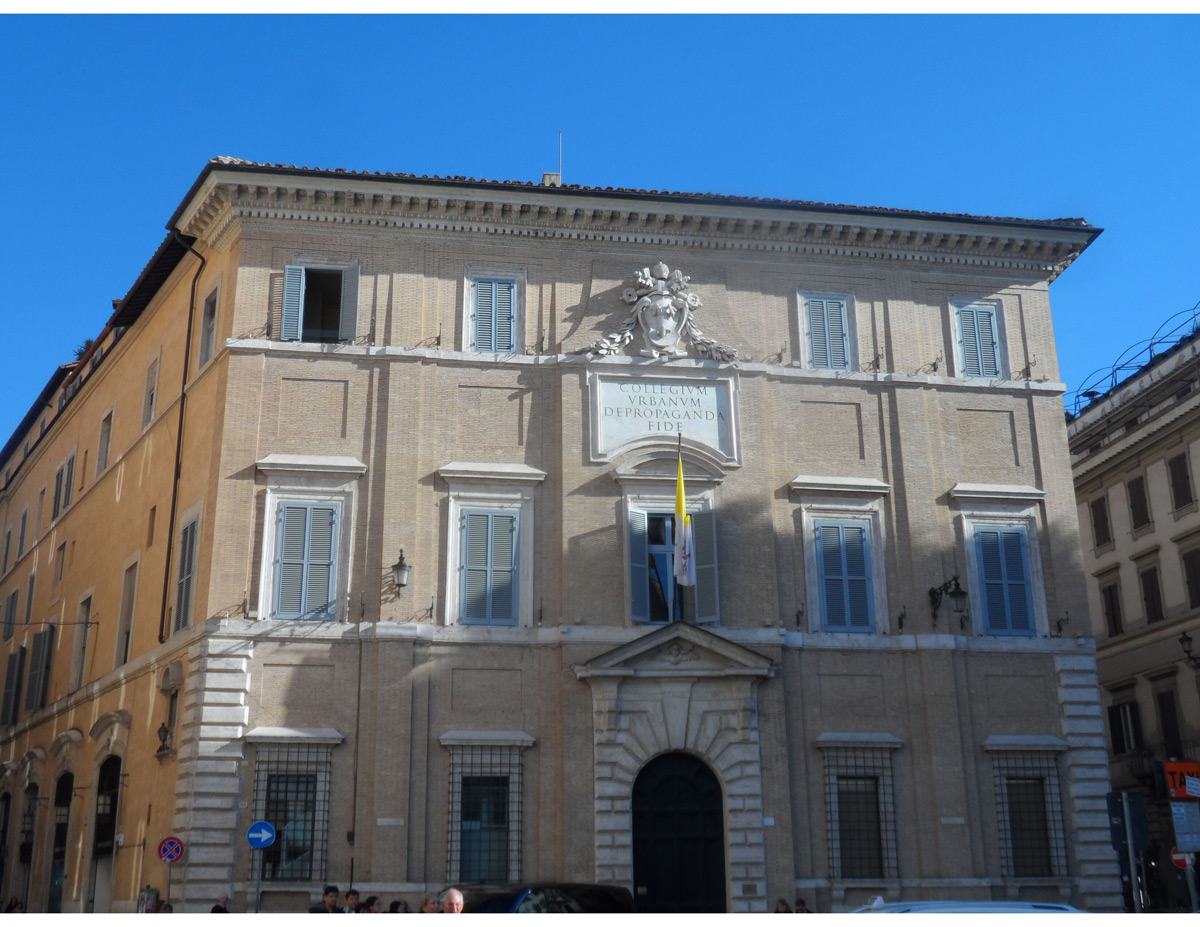
 John Kulandai
John Kulandai

Four hundred years in the life of any institution is a rare event worthy of due celebration. Needless to say, it also provides an occasion to look back at the journey made and trace a possible future course. The Congregation of the Propaganda Fide (renamed Congregation for the Evangelization of Peoples) can legitimately be proud of its unique achievements in the course of its four hundred years of history.
Officially erected on 6 January 1622, this Congregation was the one to begin in Christian history a systematic and planned approach to and coordination of the work of mission carried out by different religious orders. Armed with sweeping administrative, juridical and even judicial powers, it could galvanize human and material resources and organize effectively missionary enterprise unhindered in most parts of the world.
While the Portuguese and the Spanish colonial powers, under the aegis of the patronage (Padroado) system, claimed control also over the mission with the danger of missionaries becoming partisans, Propaganda Fide was a force of restraint by freeing mission from nationalistic interests. Its missionaries were supranational and were imbued with a universalistic spirit.
In those days, when connectivity with other parts of the world and travel facilities were far from what they are today – imagine it took St Francis Xavier six months to reach from Lisbon to the shores of India in Goa – and when means of communication were quite elementary, this Congregation was a need of the hour to empower and support missionary work in far-flung lands.
In its earnest endeavour to reach out to peoples and nations at the ends of the earth, the Congregation provided the missionaries and the native people with Bible and other Christian literature by setting up its polyglot press in 1626, which was unique when printing was at its infancy.
Furthermore, the Congregation encouraged inculturation even before Vatican II, promoted native vocations, took efforts to train young students from all over the world in the spirit of interculturality at its Collegio Urbano de Propaganda Fide (founded as early as 1627) whose students would also provide local Church leadership for generations in many parts of the world.
There are many more remarkable achievements of this Congregation. It is worth recalling here that on the third centenary of the Congregation, an author went to the extent of stating that Propaganda Fide was “one of the greatest civilizing forces the world has ever seen.” [Peter Guilday, “The Sacred Congregation de Propaganda Fide”, in The Catholic Historical Review vol 6, no 4 (1921) 478-494, at 490]. My purpose here is not to present the multifarious achievements of this Congregation exhaustively, but rather reflect on the prospects of this Congregation, given that we are in a vastly changed Church and the world with new questions, problems, and challenges.
“Mission Territories”
In many official documents, the goal of this Congregation is specified as that of bringing the Good News to "mission territories". However, to think and speak in these terms do not take into sufficient account the incredibly changed circumstances of today. Though once countries under Protestant domination were included under propaganda Fide like United States, Canada, Australia, etc. these and other economically developed countries ceased to be part of it, and, in practice, it is the poor parts of the world – Asia, Africa, and Oceania – that are under the direct jurisdiction and supervision of this Congregation.
The territorial conception was further reinforced when Pope Benedict XVI created a Pontifical Council for Promoting the New Evangelization, which practically meant efforts to do mission in financially well-to-do parts of the world which were interpreted to have become secular.
Today, we realize that mission needs to be pursued in every part of the world, and it would be anachronistic to label some countries as "mission territories". Perhaps more Catholics attend Sunday mass in China, India, and Korea than all of Western Europe. Even more, India and Korea have become countries from where missionaries go to other parts of the world – Africa, Oceania, Latin America, etc. Pope Francis views evangelization in much broader and universalistic terms, as we could note in his Evangelii Gaudium. Secularization is global, not confined to any one part of the world.
The colonial hangover expresses itself also in the way sometimes bishops from the “mission territories” are treated. Not few bishops from Asia who have shared in confidence with this author told how they were being lectured down when they went for ad limina visit, very different from how bishops from more affluent countries were treated in different dicasteries. There could be more efforts to listen and understand the local situation. After all, the curia is only a service organization, and it cannot infringe upon the legitimate autonomy of the local Churches by excessive bureaucracy.
The financial dependence by way of subsidy and the inherited colonial acquiescent and submissive – not to say slavish - mentality have robbed the bishops of ‘mission territories’ of self-confidence, and they are reluctant to voice boldly and confidently their views. Times have changed, and now it has become more and more necessary that the dealing with the Roman Curia of the bishops from Africa, Asia, and Oceania be mature and on par with other countries and that they have direct access to the various dicasteries and not dependent upon only on the Congregation for the Evangelization of Peoples which has, as I mentioned, enjoys sweeping powers over the “mission territories”.
Reinventing the Congregation?
If this Congregation were to continue a meaningful service, it would require a new vision about global Christianity and reinvent its goals and objectives under vastly new conditions. Besides the change in the conception of mission, the “mission territories” under its supervision have new questions and challenges to respond about which those working in this Congregation need to be adequately equipped to deal with.
One begins to wonder whether this Congregation is really a locus of fresh vistas, perspectives, and creative new initiatives. What we require is a complete rehauling of this Congregation. For, in the eyes of many critically thinking faithful, this Congregation has become a kind of funding agency on which the poorer part of the Catholic world depends for financial assistance.
Modernization of the Congregation
I think those serving in this Congregation would require familiarising themselves with a good dose of post-colonial theories and studying how post-colonialism reviews the colonial heritage. Colonial experience has shaped the modern world, no less the Church in the developing world, and it continues to linger. Neo-colonialism and mission are not unconnected, and this bond – often unconscious -- can affect attitudes.
Knowledge of Canon Law cannot substitute for knowledge about the political, social and cultural situation in these different countries. Having such overarching powers, it is easy for the officials in this Congregation, without sufficient inter-disciplinary enlightenment on the ground, to make questionable decisions and formulate policies that one may regret later, with so much harm done in the meantime.
With enormous assets and material means at the disposition of this dicastery, and with no effective financial control as in the case of other curial offices, there is a real danger of gross misuse as experience and history attest. Part of the modernization process would be introduction of greater financial accountability of this Congregation.
It may be recalled here that in the early years, the very first secretary of the Congregation, Francesco Ingoli, commissioned a thorough study of the situation to find out the strength and weaknesses in the mission field to draw suitable policies and directives which helped it to steer the future direction and tone up its internal organization accordingly.
In fact, Ad Gentes directs this Congregation to "make use of scientific methods and means suited to the conditions of modern times, always taking into consideration present-day research in matters of theology, of methodology and missionary pastoral procedure" (AG, 29). One crucial area where it should be urgently applied is in the process of appointing bishops.
Appointment of Bishops
One of the major works done by the Congregation of the Evangelization of Peoples is to process the candidates for episcopacy and present them to the Pope for the appointment. To discern God's will, it is important that there be human cooperation through which the best scientific methods are employed in selecting the candidates for the episcopacy.
Unfortunately, there have been cases of appointments of curial officials and those in the Vatican diplomatic service as bishops from above, with no consultation at all with the local Church and sometimes not even with local bishops, a mode of practice not acceptable in the post-Vatican period, and would constitute an insult to the local Church.
There was not one single model throughout history for the selection of bishops. More than one thousand ecclesiastical circumscriptions depend on this Congregation for the appointment of their bishops or heads – making up almost 40% of the hierarchy of the Catholic Church. Added to it is the fact that more than 60 bishops’ conferences from "mission territories" refer to it. Obvious is then the heavy responsibility this dicastery bears.
This is a highly responsible job the Congregation does, and it needs today to be evaluated. As it is, it seems to lack modernization of methods. The consultations in many cases, appear to be very arbitrary and limited (often for fear that secrecy will be violated), as a result of which the quality of the candidates suffer as they are often far from being open to the challenges of contemporary times.
Either one should introduce a synodal structure also for the Latin rite for the choice of bishops as in the Oriental Churches, or give power to the regional or national bishops' conference for the election of bishops, the candidates to be only ratified by the Pope. In this way, a big load of the work of the Congregation for the Evangelization will be taken away.
Modern management methods need to be applied profitably by the Congregation until the synodal structures are established, or bishops’ conferences are empowered. The questionnaire sent for consultation in appointing bishops needs to be formulated with the help of the Bishops’ Conferences so that they are set in context.
Conclusion
There has been an epochal shift in the understanding of mission in our times. The future of mission will look different if this Congregation follows two crucial principles: First, the principle of subsidiarity, something which has been an integral part of the social teaching of the Church since Quadragesimo Anno (1931) of Pope Pius XI, and it applies as much to the Church as to the society. The Congregation need not take on itself what can best be accomplished at the level of the local Churches. The second important principle is that of collegiality and episcopal conferences. If the episcopal conferences are strengthened and empowered theologically and juridically, they could really perform many of the things presently done by this Congregation.
A new document on the reform of the Roman Curia is expected in the near future. The Congregation for the Evangelization of Peoples and the Pontifical Council for Promoting the New Evangelization may be merged into one. However, this would be simply an organizational change and not going far enough to trace a new direction.
Let me put forward some proposals. There is not much point in this Congregation continuing in the present form, given the significant changes I alluded to and the challenges faced by the local Churches in the "mission territories". These territories could be brought under different Congregations and curial offices with which the local Churches will deal directly, including in matters of appointment of bishops. In this way, they will be on par with other parts of the world in their relationship with the Roman Curia. This would make them self-governing, autonomous local Churches in communion with other Churches in different parts of the world and in communion with the universal Church.
Whatever transmutation the Congregation undergoes, one thing is sure, that it cannot continue in the present form and manner and with its present powers. The Congregation could be devolved into a Pontifical Council for Evangelization in Critical Situations. The territories undergoing persecution and other political turmoil could be brought for an interim period as an emergency measure under this Pontifical Council and supported with the necessary means.
The second function of this Pontifical Council could be that of assistance with material resources for mission, and that too in any part of the world, without any territorial specification. In fact, many “mission territories” under the Congregation are becoming progressively independent with their own local resources and even financially self-supporting.
The four hundred years of history has endowed this Congregation with so much wealth of knowledge and insights that it can indeed reinvent for itself a new avatar.
(The writer is a former member of the International Theological Commission of the Vatican, and former secretary of the Theological Advisory Committee of the Federation of Asian Bishops’ Conferences. The German version of the article appears in Forum Weltkirche, Missio, Aachen)